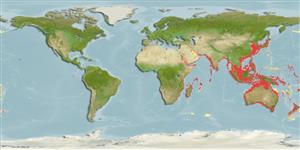Preferred temperature (Ref.
123201): 15.7 - 28.2, mean 25.2 °C (based on 1516 cells).
Phylogenetic diversity index (Ref.
82804): PD
50 = 0.5312 [Uniqueness, from 0.5 = low to 2.0 = high].
Bayesian length-weight: a=0.00513 (0.00287 - 0.00918), b=3.04 (2.88 - 3.20), in cm total length, based on LWR estimates for this species & (Sub)family-body (Ref.
93245).
Trophic level (Ref.
69278): 3.9 ±0.60 se; based on food items.
लौटाव (Ref.
120179): माध्यम, न्यूनतम जनसंख्या दुगनी होने का समय 1.4 - 4.4 वर्ष। (Preliminary K or Fecundity.).
Fishing Vulnerability (Ref.
59153): Moderate vulnerability (40 of 100).
Nutrients (Ref.
124155): Calcium = 37.9 [18.7, 109.0] mg/100g; Iron = 0.539 [0.251, 1.194] mg/100g; Protein = 18 [16, 20] %; Omega3 = 0.165 [0.071, 0.472] g/100g; Selenium = 55.6 [25.5, 139.1] μg/100g; VitaminA = 65.5 [22.6, 202.5] μg/100g; Zinc = 1.16 [0.75, 1.78] mg/100g (wet weight);
